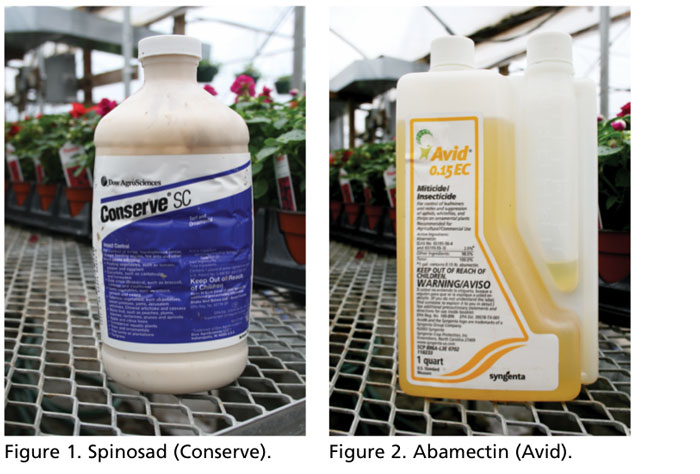3/1/2019
Mode of Action Groups 5 and 6
Dr. Raymond A. Cloyd

Insecticides and miticides are commonly used to alleviate problems with insect and mite pests feeding on greenhouse-grown horticultural crops. However, continual reliance on insecticides and/or miticides can lead to resistance developing in insect and/or mite pest populations. Therefore, you need to understand the mode of action(s) of insecticides and miticides to design effective rotation programs that will mitigate or delay resistance.
Mode of action is how an insecticide or miticide affects the metabolic and/or physiological processes of an insect or mite pest. The mode of action of all insecticides and miticides can be found in the Insecticide Resistance Action Committee (IRAC) document entitled, “IRAC Mode of Action Classification Scheme” that’s available at www.irac-online.org.
This article discusses the IRAC mode of action Groups 5 and 6. The Group 5 (spinosyns) mode of action designation is referred to as nicotinic acetylcholine receptor (nAChR) modulators. The Group 6 (macrocyclic lactones or avermectins) mode of action designation is referred to as glutamate or gamma-aminobutyric acid (GABA)-gated chloride channel modulators.
Acetylcholine and glutamate are major neurotransmitters that are responsible for transferring nerve signals between nerves and muscles, or other nerves in the insect or mite pest central nervous system. Regarding currently commercially available insecticides/miticides used in greenhouse production systems, the active ingredient associated with Group 5 is spinosad (Conserve, Figure 1) and the active ingredient affiliated with Group 6 is abamectin (Avid, Figure 2).
Group 5: Spinosyns
Spinosad is a metabolite produced during fermentation of the actinomycete, Saccharopolyspora spinosa, which is a soil-inhabiting microorganism. Spinosad is a mixture of spinosyns A (85%) and D (15%), which are the two biologically active metabolites responsible for insecticidal activity. Spinosad is registered for use against a number of insect pests of greenhouse-grown horticultural crops, including thrips, caterpillars and leafminers.
Spinosad has two modes of action: The first mode of action involves disrupting/inhibiting the binding of acetylcholine at the nicotinic acetylcholine receptors located at the post-synaptic cell junctures, which prolongs stimulation or activation of the nicotinic acetylcholine receptors. Consequently, this results in excitation of the insect central nervous system, paralysis and eventually death.
The second mode of action is affiliated with negatively affecting GABA-gated ion channels. The mode of action of spinosad is similar to the neonicotinoid insecticides (imidacloprid, dinotefuran, thiamethoxam and acetamiprid) in IRAC Group 4, as both groups target similar proteins on receptor sites. However, spinosad is active on different target sites on these proteins. Furthermore, whereas neonicotinoids directly bind to the receptors, spinosad binds partially to the receptor and changes the shape.
Spinosad also has a similar mode of action as Group 6 (see below) by acting on the GABA-gated chloride channels, but at a different target site in the nervous system. Consequently, spinosad and abamectin should never be applied successively in rotation programs against western flower thrips (Frankliniella occidentalis). In fact, populations of western flower thrips have developed resistance to spinosad based on modification of the target site (nicotinic acetylcholine receptor), which reduces sensitivity, however, enhanced metabolic detoxification may also be involved.
Group 6: Macrocyclic lactones or avermectins
Macrocycle lactones are products or chemicals derived from soil microorganisms in the genus Streptomyces. Abamectin is closely related to a naturally-occurring macrocyclic lactone that’s produced from the fermentation of the soil microorganism, Streptomyces avermitilis, and is a mixture of avermectin B1a (>80%) and B1b (<20%) with both insecticidal and miticidal properties. It’s registered for use against mites, leafminers, aphids, thrips and whiteflies.
Abamectin activates or promotes the opening of the GABA-gated chloride channels associated with the insect central nervous system. After acting on the macrocyclic lactone binding sites on the chloride channels, chlorine ions (Cl-) flow into the nerve cells resulting in continuous excitation of the central nervous system, paralysis and eventually death. Certain twospotted spider mite (Tetranychus urticae) populations in greenhouse production systems have developed resistance to abamectin by means of enhanced metabolism associated with specific enzymes and target site insensitivity. GT
Dr. Raymond A. Cloyd is State Extension Leader for Entomology, and Professor and Extension Specialist in Horticultural Entomology/Plant Protection for Kansas State University in Manhattan, Kansas. He can be reached at (785) 532-4750 and rcloyd@ksu.edu.